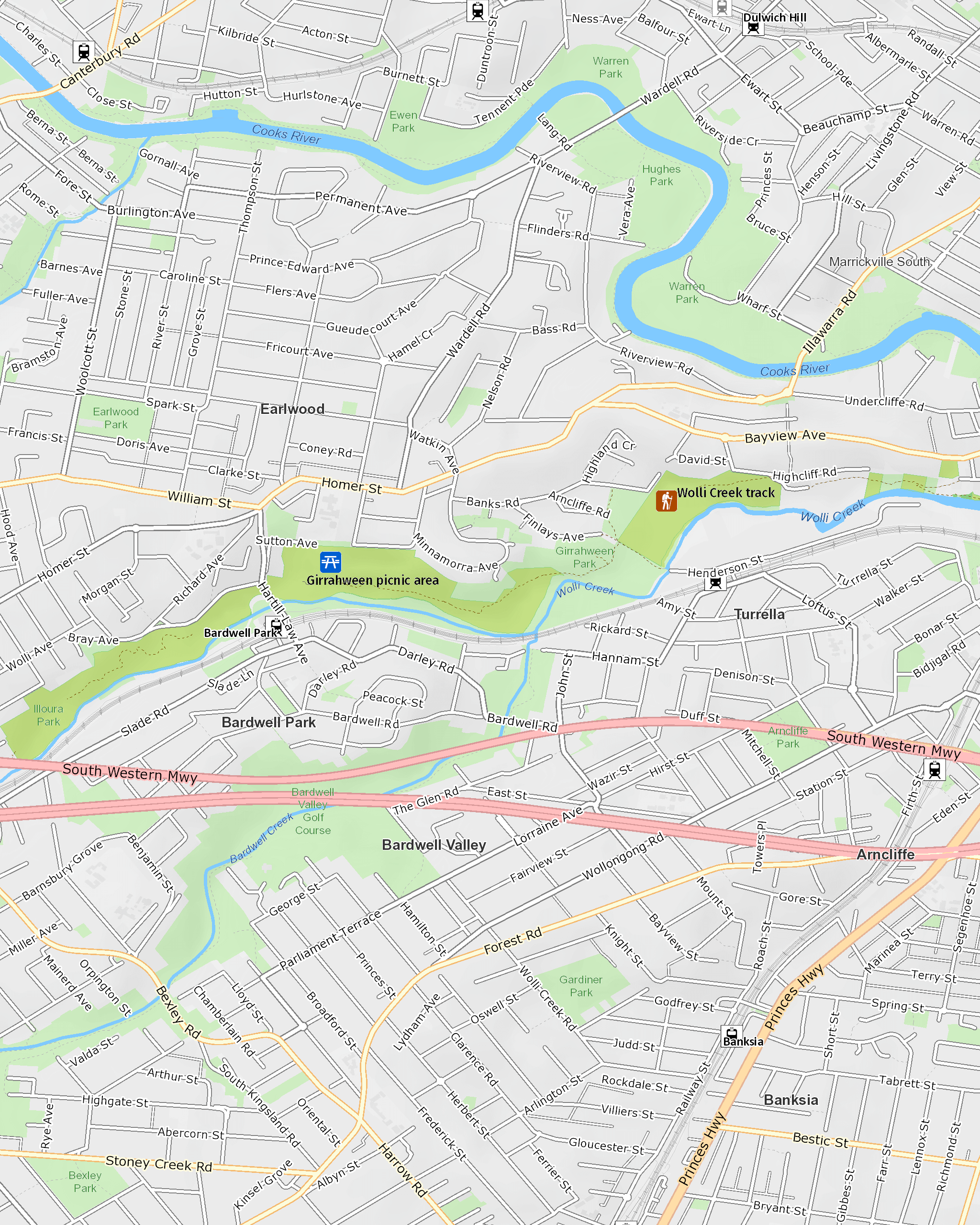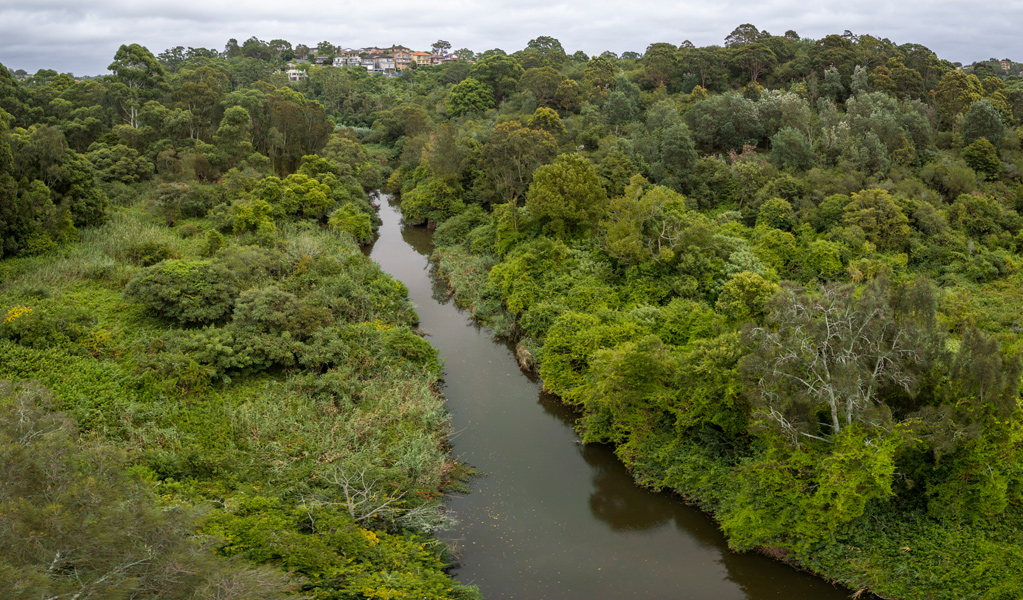Wolli Creek Regional Park
Overview
Wolli Creek Regional Park is a precious pocket of bushland in Sydney. Volunteer to help out, enjoy a bushwalk, take your dog for a walk on a leash or have a picnic or barbecue..
Read more about Wolli Creek Regional Park
Wolli Creek Regional Park is a long sliver of greenery in Sydney’s urban inner southwest; a beautiful gem in the suburbs.
It’s an important place for the local community and the Wolli Creek Preservation Society continues to play an active role in bush regeneration activities. The park conserves a richly varied vegetation corridor along Wolli Creek, providing a home for an astonishing array of birdlife and grey headed flying foxes.
It’s a great place for a morning walk along the Wolli Creek track, part of the longer Two Valley trail via Campsie and Bexley. If you’re looking for a new barbecue spot, try Girrahween picnic area or the nearby Turella Reserve.
Local alerts
For the latest updates on fires, closures and other alerts in this area, see https://www.nationalparks.nsw.gov.au/visit-a-park/parks/wolli-creek-regional-park/local-alerts
Map

Map legend

Contact
- in the Sydney and surrounds region
Wolli Creek Regional Park is always open but may have to close at times due to poor weather or fire danger
-
-
Nielsen Park office
02 9337 5511
Contact hours: Monday to Friday, 9am to 5pm. - Greycliffe House, Nielsen Park, 6 Steele Point Road, Vaucluse NSW 2030
-
Email: npws.sydneysouth@environment.nsw.gov.au
-
Nielsen Park office
Visitor info
All the practical information you need to know about Wolli Creek Regional Park.
Maps and downloads
Nearby towns
Sydney City Centre (13 km)
No trip to Sydney is complete without spending some time in the city’s beautiful parks. Whether it’s in central areas like Hyde Park or the Royal Botanic Gardens or further out in Centennial Parklands, there’s plenty of green space to go out and enjoy.
Parramatta (25 km)
Parramatta offers a fascinating insight into early colonial life in Australia. Don't miss a visit to Old Government House, now one of 11 Australian Convict Sites on the UNESCO World Heritage list.
Learn more
Wolli Creek Regional Park is a special place. Here are just some of the reasons why:
Bird haven

Wolli Creek Regional Park is an important habitat for a variety of birds. Look for cormorants and darters as you're walking by the creek and keep an eye out for blue wrens and finches on the edge of the open lawns. In the sky you may catch a glimpse of brown goshawks and peregrine falcons on patrol.
- Wolli Creek walking track It’s such a treat to be able to take a bushwalk in the city. Look out for the amazing birdlife and enjoy the serenity of this short and easy walk.
Stretch your legs in the city

Just because you live in the city, it doesn’t mean you can’t enjoy the bush. Go for a run, take a leisurely stroll with the dog or let the kids burn off some energy on the trails and in the play areas. Wander the Wolli Creek walking track with its sandstone cliffs or walk the entire Two Valley trail. There are also several gorgeous spots around Wolli Creek Regional Park to meet family and friends for a barbecue or picnic. Relax on a rug while the kids play at the playground at Turrella Lawns or enjoy a quiet family picnic in the shade at Girrahween picnic area.
- Girrahween picnic area Enjoy a barbecue and laze under the trees at Girahween picnic area in Wolli Creek and leave the hustle and bustle of the city behind.
Plants and animals protected in this park
Animals
-

Grey-headed flying-fox (Pteropus poliocephalus)
The grey-headed flying fox is Australia's largest native bat, with a wingspan up to 1m. This threatened species travels up and down south-eastern Australia and plays a vital role in pollinating plants and spreading seeds in our native forests.
Environments in this park
Education resources (1)
What we're doing
Wolli Creek Regional Park has management strategies in place to protect and conserve the values of this park. View the detailed park and fire management documents. Here is just some of the work we’re doing to conserve these values:
Preserving biodiversity
NPWS is committed to protecting all native species, and regeneration and conservation programs operate within Wolli Creek Regional Park. Natural heritage features are protected, managed and interpreted, and recreation facilities are upgraded, where required. Efforts to minimise the impact of threats to the park’s biodiversity are ongoing.
Managing weeds, pest animals and other threats
Pests and weeds have a significant impact to the ecosystems within Wolli Creek Regional Park. NPWS carries out risk assesments for new and emerging weeds to protect biodiversity in this park.
Developing visitor facilities and experiences
By providing quality visitor facilities and conserving park landscapes, NPWS works to increase opportunities for people to visit and experience Wolli Creek Regional Park. Park staff work to encourage public enjoyment of the area and its bushland. Walking tracks and trails are maintained and environmental enhancement programs are ongoing.
Conserving our Aboriginal culture
Aboriginal cultural heritage is of great value to NPWS. Ongoing projects are in place in Wolli Creek Regional Park to audit, monitor and maintain the condition of its cultural sites and assets. Working with local councils and Aboriginal communities, NPWS works to protect, maintain and interpret all items of significance.
Managing fire
NSW is one of the most bushfire prone areas in the world as a result of our climate, weather systems, vegetation and the rugged terrain. NPWS is committed to maintaining natural and cultural heritage values and minimising the likelihood and impact of bushfires via a strategic program of fire research, fire planning, hazard reduction, highly trained rapid response firefighting crews and community alerts.

